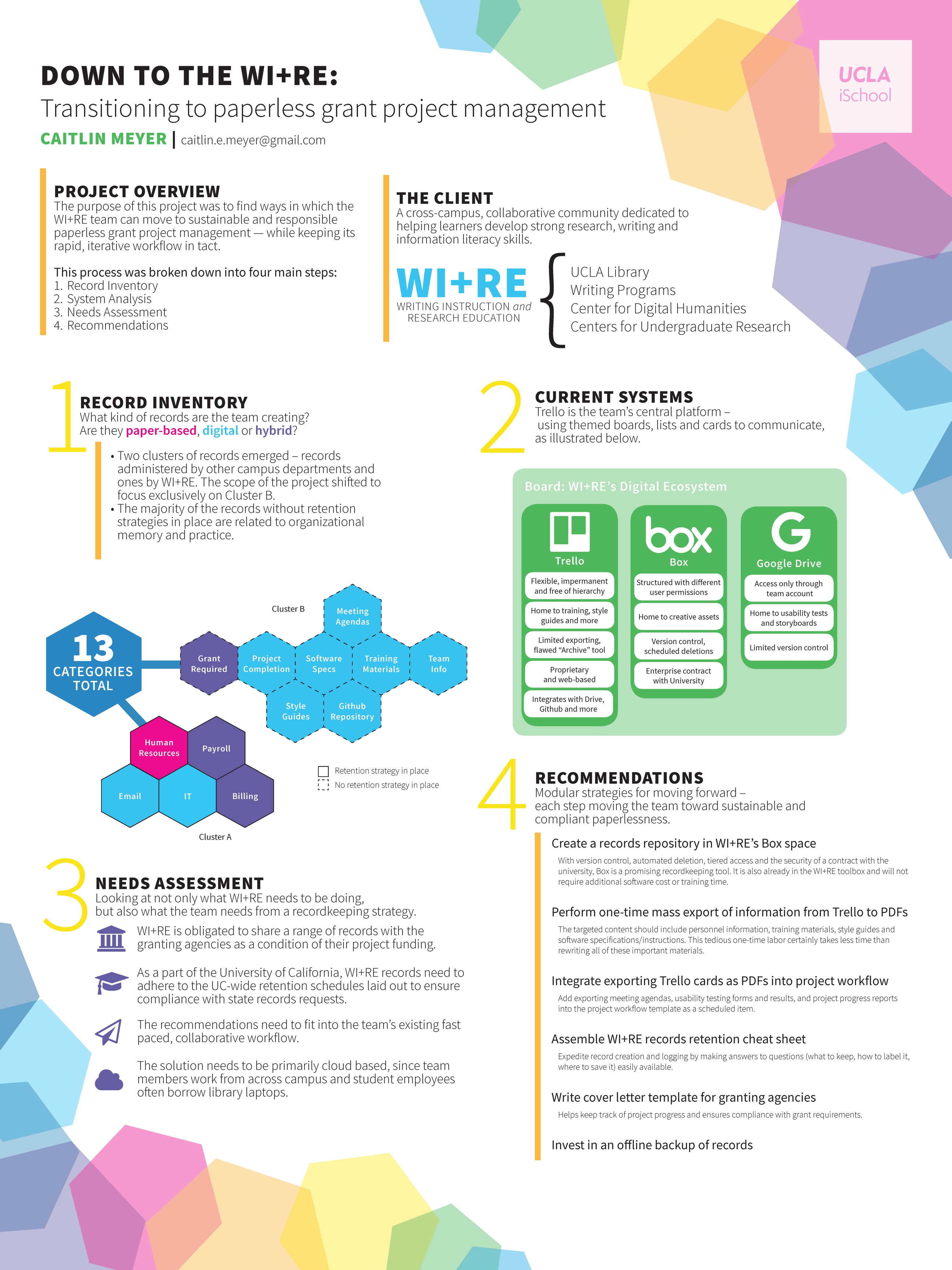
The purpose of this endeavor was to find sustainable, responsible ways in which the interdepartmental Writing Instruction + Research Education (WI+RE) team at UCLA can move to paperless grant records and project management. In order to contextualize the attached report, it is first necessary to untangle the various contexts (social, institutional, technological) that inform the records keeping practices of the team. The work below reveals a complex web of team goals, institutions, and gaps in records management strategies. The collaborative, cross-campus nature of the team mandates, where institutionally permitted, digital records. Reliance on paper to communicate and document would render the iterative, rapid pace the team likes impossible. The priority is to design a strategy that navigates the space between WI+RE’s commitment to openness and enthusiasm for technology with the institution-atlarge’s sluggish, bureaucratic nature.
This report provides an evaluation an analysis of record keeping practices at the UCLA LGBT Center's Rae Lee Siporin Library, focusing on circulation procedures and catalog workflow. This assessment is based on interviews, observation of the library, and analysis of paper and digital records. The results of analysis show that the current intern has developed a workflow out of a variety of historical processes that maximizes the number of books that are cataloged and adheres to the Center's values of access and privacy. However, this workflow is time-consuming for circulation procedures and results frequently in inaccurate circulation information. Additionally, this workflow is only as effective as the library's knowledge transfer practices, as the library intern position has frequent turnover. The report finds that shifting some paper-digital hybrid record keeping procedures to fully paper and others to fully digital will help the center further adhere to its values of access and privacy.
This project focuses on an auction house specializing in Asian art and antiques located in Southern California. Items sold by the auction house include not only Asian art and antiquities, but also jewelry, watches, fine art, gems, and fossils with hammer prices ranging from $100 to $1,000,000. The nature of its inventory requires proper documentation and sensitivity for issues of provenance and international trade agreements such as those regarding repatriation and regulation on the imports of potentially smuggled items. The employees self-identify their current document environment as a hybrid one. Digital workflows are at many points interrupted by paper for various reasons, many of which lead to inefficiencies, delays, and redundant labor. There are also a number of legacy documents, primarily past auction records, that often need to be consulted. The auction house's goals for a consultation regarding their digital records are primarily a matter of efficiency. They recognize that paper provides affordances and that in particular, their clientele is often most comfortable with paper for its perceived ability to convey legitimacy.
Our group worked and consulted with the owner of a small, private chiropractic practice who was seeking to begin the process of digitizing patient medical records and installing an electronic medical record (EMR) system. Our group was asked to make a recommendation on whether the practice should upgrade its front-office software system, Chiro8000, in order to have access to its built-in electronic medical records (EMR) functionality. This digital EMR system would replace the office's existing paper-based medical records workflow. After analyzing both the paper and digital systems, we recommend that the office upgrade to the digital EMR system. After going through a demonstration of the new EMR system with Chiro8000 representatives and considering potential costs and benefits, we believe the practice would benefit from its adoption.
In order to investigate the transition from paper to electronic admission records at iSchool, interviews of stakeholders of the admission process have been conducted, ranging from students, to admission committee members, and to student affairs officers. It was discovered that the current workflow of admission records at iSchool has negative impacts on not only the sustainability, but also the efficiency and cost of the recordkeeping at iSchool.
This project built off a previous avenue of research and analysis completed by members of UCLA’s Information Studies class, “Introduction to Data Informatics” in winter quarter 2016. We further examined the Internship Program, originally reported on by Kip Holcomb and Yaqi Zhang. We conducted further inquiry into recommendation 5.2.2: Digitize program forms and other information in order to increase access, preservation, and meet other 'strategic goals.'
The report provides an analysis of a small legal office's current paper and electronic document management. This report makes recommendations to improve and streamline the process so that the office can conduct their business more efficiently and productively. We found three major risks that we attempted to address in our recommendations: 1) the workflow is not optimal for digitizing documents, 2) communications and task management are dispersed across multiple platforms and devices, and 3) the firm does not take advantage of existing systems for organizing and categorizing electronic documents.